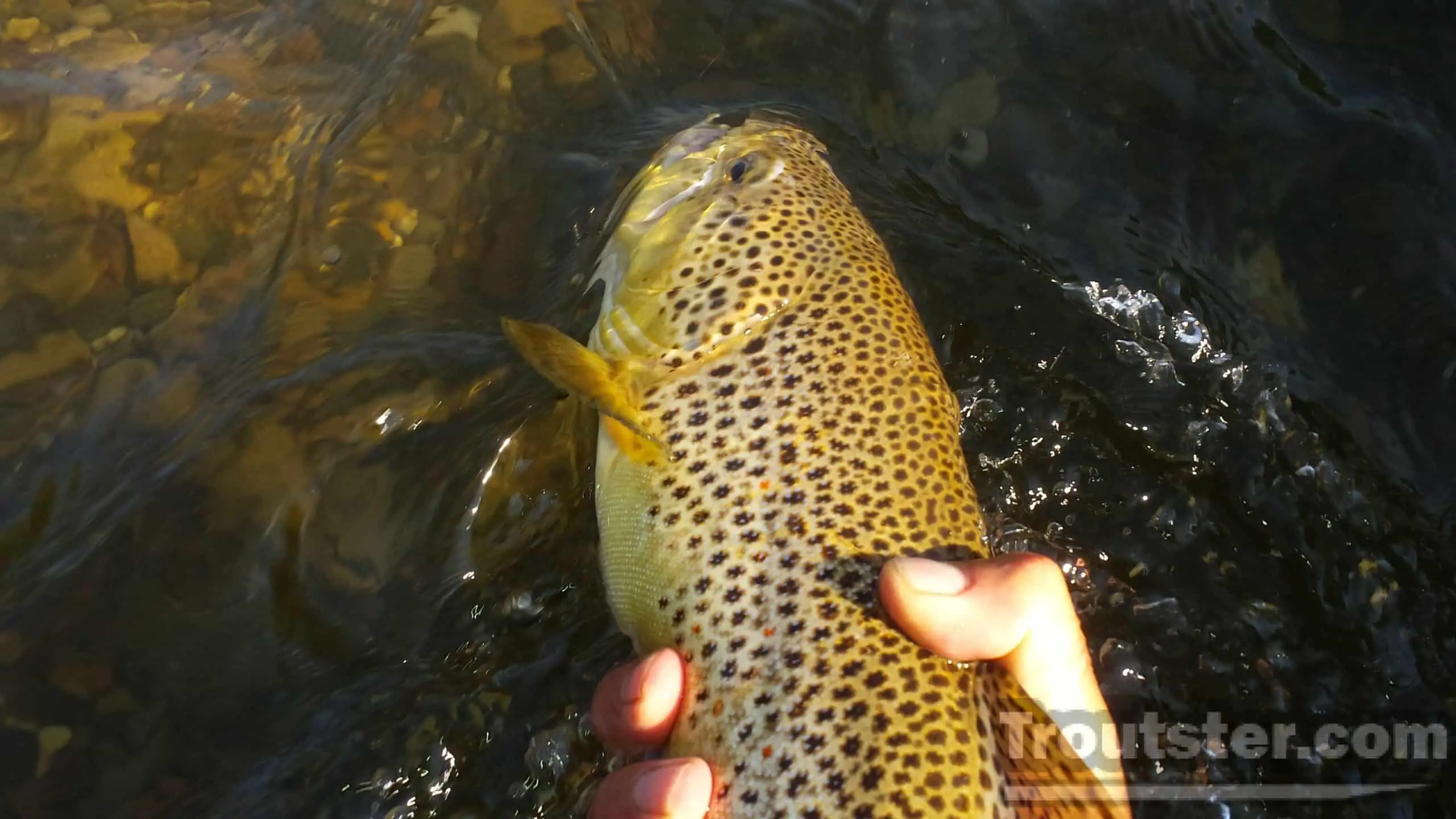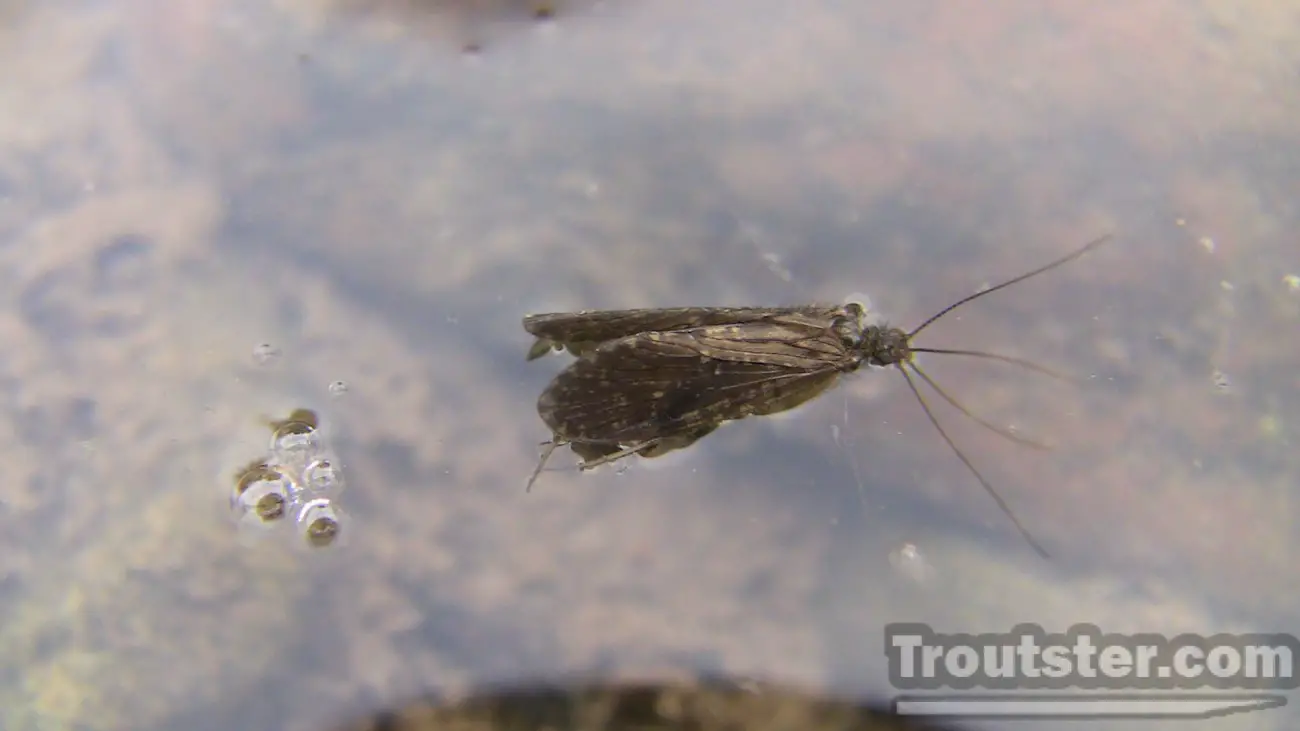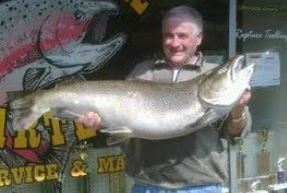This post was last updated on February 11th, 2023 at 06:18 pm
About the Brown Trout – Salmo Trutta
Check out this comprehensive Brown Trout guide including many resources from brown trout fishing, brown trout spawning information and much more.
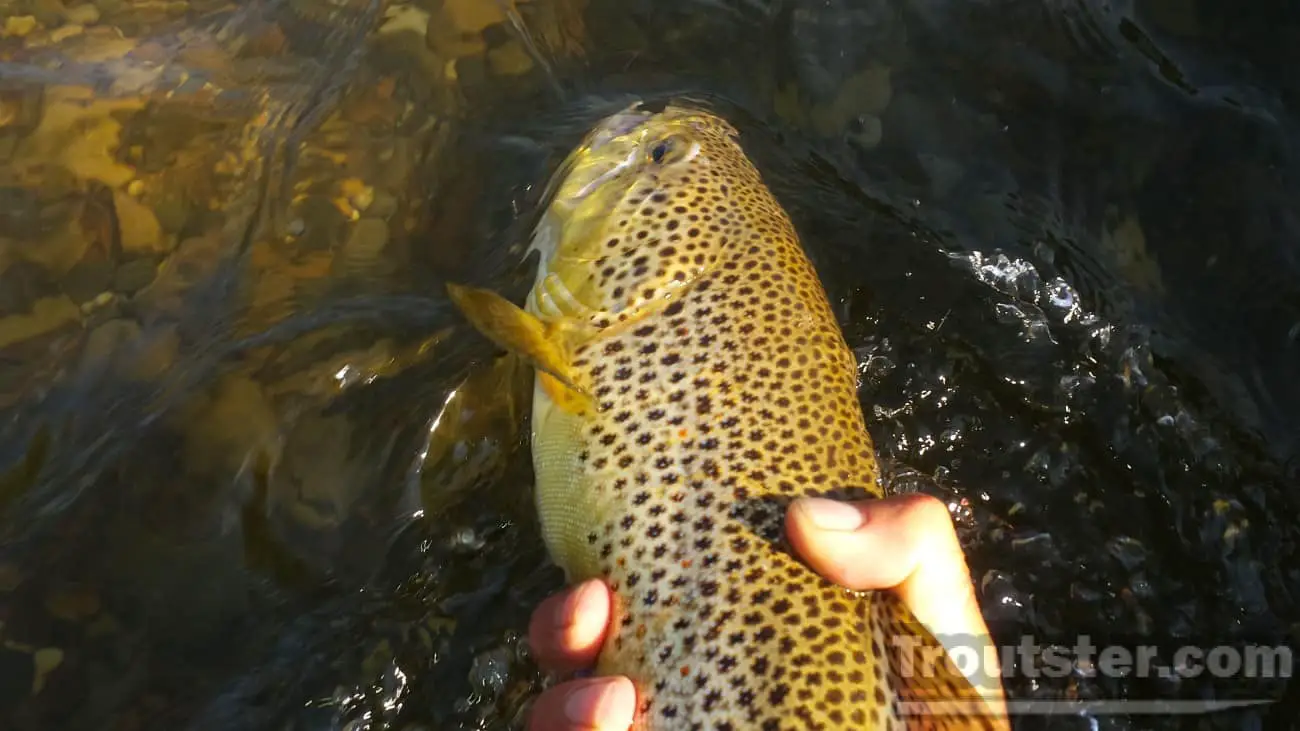
Fishing for Brown Trout
These voracious fish can be caught in a lot of different ways. Many people enjoy using conventional tackle with live bait or lures, but the most common way to catch them is by fly fishing. They are probably the most popular species of trout to catch because of the great fighting ability they possess and their eagerness to attack lures, flies and live baits.
Check out this fly fishing for brown trout video filmed in Oregon in spring 2017. Some of the best fishing I’ve ever seen.
Current Range of the Brown Trout in the USA
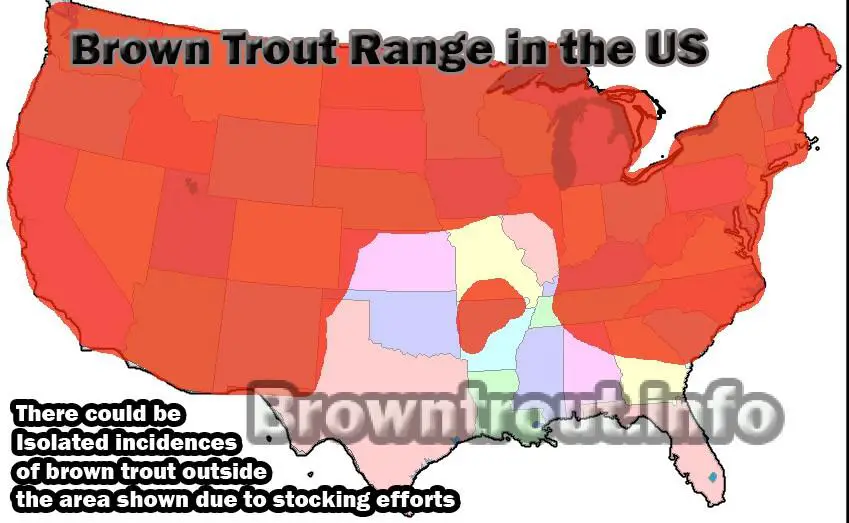
After the initial release of the Brown trout, it spread quickly across the US. It was later planted in the Rocky Mountain region and also reacted well to the environment. The Brown trout has Wild Breeding populations in 35 of the 50 states. As shown in the diagram, the range might differ slightly due to local efforts of stocking the brown trout. Much of the areas shown have only small populations in isolated mountainous areas. The brown requires cold water which many low elevation areas aren’t capable of providing.
What Do Brown Trout Eat?
The Carnivorous Brown trouts diet is made up of mostly small insects and Larvae for the first part of its life. Once the trout reaches just a few inches it will begin to consume anything it can fit in its mouth.
Stoneflies
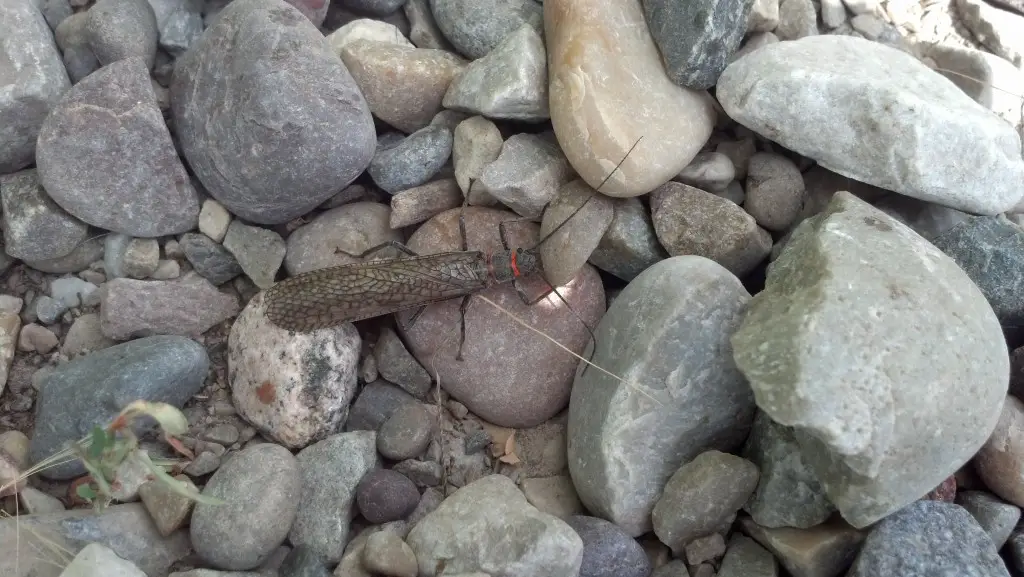
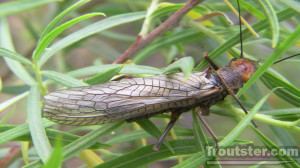
These are a significant part of the insects that brown, and other trout gorge themselves on out west. Some are quite huge! There are a lot of different varieties. Some of the largest ones are known as salmon flies. They are orange colored with dark wings. A slightly smaller version in a yellow color are commonly referred to as “goldens” or golden stones. There are endless varieties of smaller ones throughout the world. One of which is the yellow sally, or “red tag” called this because of the red behind it has.
Caddis
Caddis are another insect that spend their life around the water. They have what is known as “tent” shaped wings and are very distinctive. Fish do eat a lot of caddis, especially the nymphs. In my personal observations these rank quite low on the list of favorite trout foods. There are a lot of times where trout eat them vigorously, but I wouldn’t get excited if I saw caddis start hatching. If you are interested in reading more about the caddis see: The caddis fly life cycle page
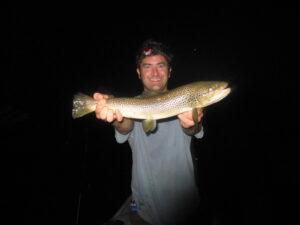
Large brown trout will regularly feed upon small insects especially during a hatch. But there is a tipping point where large trout begin to eat larger prey. In order to eat more calories per meal than they are expending it is best to go “cannibal”.
After fly fishing for trout most of my life I have come to the conclusion that there are large brown trout in the river that almost never feed on insects. In order to catch them you need to use very large streamer patterns and mouse patterns at night.
Fishing the same stretches of river day in and day out with flies will tell you, that if there is a large trout there it should eventually fall victim to a nymph floating in front of its face perfectly presented. In my experience I seen several large brown trout in particular areas where they obviously consider this spot home. I could drift small flies there on the lightest tippet all day long and the fish would never come out and eat it.
Yet I could go there after dark and regularly get a reaction out of the fish after 1 cast on a large mouse pattern. The same seems to hold true for days where trout are eating streamers. I could cast there one time and the large resident trout that I know is there will come out and eat it. My conclusion.. The huge trout want to eat huge stuff!
A trout could sit there all day sipping up small nymphs or it could eat the equivalent amount of food in one meal. Why sit there all day expending energy when you can simply eat one or two meals a day and be done with it. I cannot even count the number of times that I have seen someone pulling in a small trout, when out of the depths comes a huge brown attempting to eat the smaller fish they hooked. Yet that trout was there all day watching dozens of fisherman’s flies go over it.
Do Brown Trout Eat Other Fish?
Sculpins
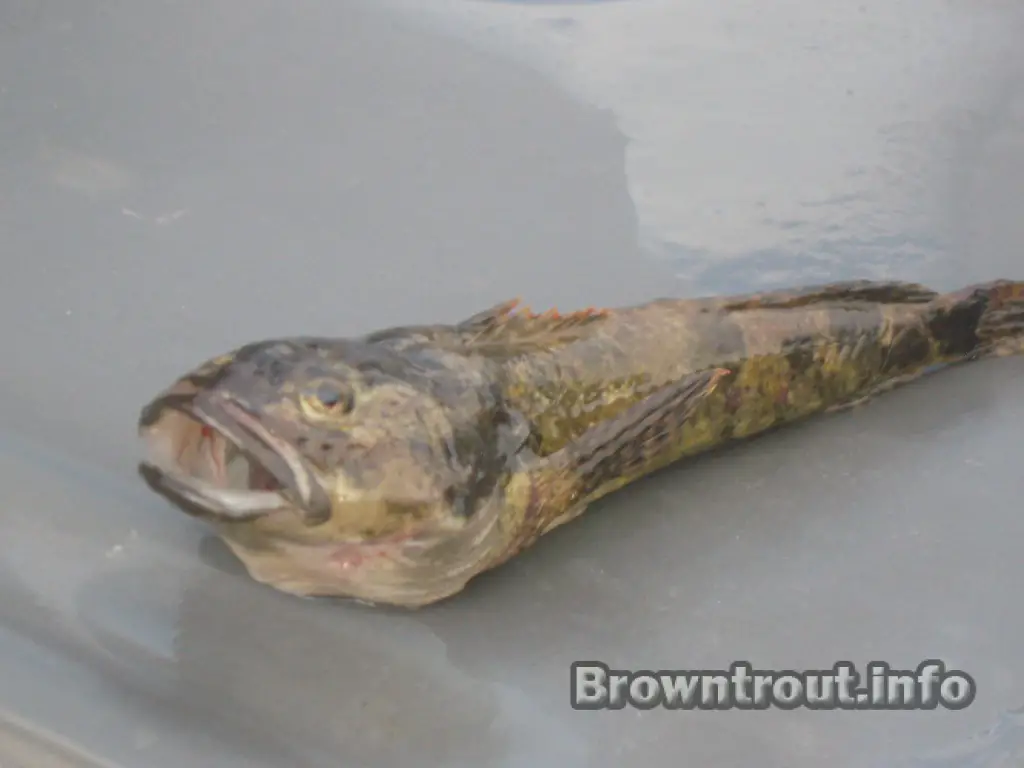
Sculpins are a small fish present in most rivers in the US. The trout will feed heavily on these fish. They are rather small with large pectoral fins resembling a type of saltwater fish in a way. The sculpins rest in the cracks on the bottom of the river feeding on small nymphs and freshwater shrimp. They blend in well in their environment around the brown river bottoms. They tend to sit very still most of the time using their protective mimicry to their advantage, only swimming away when they know they have been spotted.
Other Trout, Yes Trout are Cannibals!
There is no limit to the size of trout a large brown will eat. If it can be consumed it is in danger of being eaten. I have seen trout up to 12″ be attacked by a large brown trout. Large browns are the bosses of the river and they can eat a serious amount of protein fast because of their aggressive nature and size.
Mice and Small Mammals
Yes That’s right browns will eat mice, squirrels and even birds! I frequently fish for brown trout after dark using a deer hair mouse pattern. The trout seem eager to eat them and will attack these large flies with a ferocity that is totally different than when they eat smaller flies. They want to get it quickly before it gets away and I assume they want to kill or stun it with the hard hit.
I frequently fish for brown trout after dark using a deer hair mouse pattern. The trout seem eager to eat them and will attack these large flies with a ferocity that is totally different than when they eat smaller flies. They want to get it quickly before it gets away and I assume they want to kill or stun it with the hard hit.
Brown Trout History
Where Did Brown Trout Come From?
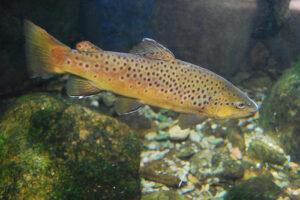
Brown trout is a wonderful fish. Perhaps the greatest fish in the world. It is a delight to catch and is one of the most sought after trout species. They have a large range. Actually Brown trout are now found globally. Brown trout introductions have been cited in North and South America, Australia, Africa and Asia. In the United States, almost all the states have documented records of brown trout sightings.
The Brown trout has been introduced in 45 of the 50 states, with a self- sustaining population in 34 states. Some other countries into which brown trout have been introduced include Argentina, Bolivia, Chile, Ecuador and Colombia in South America, as well as Madagascar, Malawi and Tanzania in Africa. In Asia, the fish has been introduced in India, Sri Lanka, Papua New Guinea and Nepal. The Brown trout was first seen in Roman literature about 200 AD.
The Brown trout was introduced into the US around 1880. They were brought on a boat from Germany in the form of eggs. The first batch went to a hatchery in long island, others were dispatched to hatcheries in Caledonia, New York. Many were also taken to a station in Northville, Michigan.
The First actual planting of brown trout was on the Baldwin river (aka creek) in April of 1884. I happen to have a friend who lives and runs a fly fishing lodge near the very spot this took place. (Baldwin creek lodge) These trout spawned and began to spread quickly. They likely move a short ways downstream into the Pere Marquette river and spread easily from there. It happens that even more brought to the United states from England, Germany and Scotland.
There were many people who predicted that the Brown trout would be a danger to the native brook trout in the eastern US. It turns out they were correct. The browns are extremely aggressive. They can tolerate warmer water than the brook trout, they also grow larger and faster. They quickly spread into a sustainable population from the eastern US all the way to the Rockies! The brown trout did however end up hurting the native brook trout populations. Brook trout were at the time already in trouble from over fishing. The brown trout has turned into a great planting success story, as mentioned not only in the United States but Many other Countries.
Brown Trout and it’s Arrival to the US in 1884

Today I took a trip to Baldwin Michigan. The historic site of the first planting of the Brown trout in the US. At a park in town they have assembled a small sign with information about the first planting of the trout.
The sign reads ” At this spot.. The First planting of the “German Brown trout” (salmo trutta) Occurred from this railroad trestle on April 11th in 1884. On that crisp April morning, U.S. Fish commission car #2, based at Northville, Michigan, was being loaded with 75,000 lake trout fry destined for northern Michigan lakes.
It was a light load for this car, which typically carried up to 3 million whitefish fingerlings, so hatchery personnel decided to also send about 5,000 brown trout fry that had hatched in mid-March. These Fish were a gift from Baron von Behr in Germany in repayment for some whitefish eggs. No one could have imagined, as the train chugged north toward Baldwin, that the little “German Brown Trout” dumped from milk cans into the Baldwin river later that day, were destined to become the most prized of all American Trout.”
This sign rests at the head of an abandoned railway known as the Pere Marquette Rail Trail. This was the Railway Used by the U.S. Fish commission to deliver and transport fish throughout the area. It is now a hiking and bike riding trail that goes nearly all the way across the state of Michigan. It starts in Baldwin and Goes all the way to Midland Michigan Nearly 80 Miles in total.
This Commemorative plaque was donated by the Dwight Lydell Chapter of the Issac Walton League in 2008.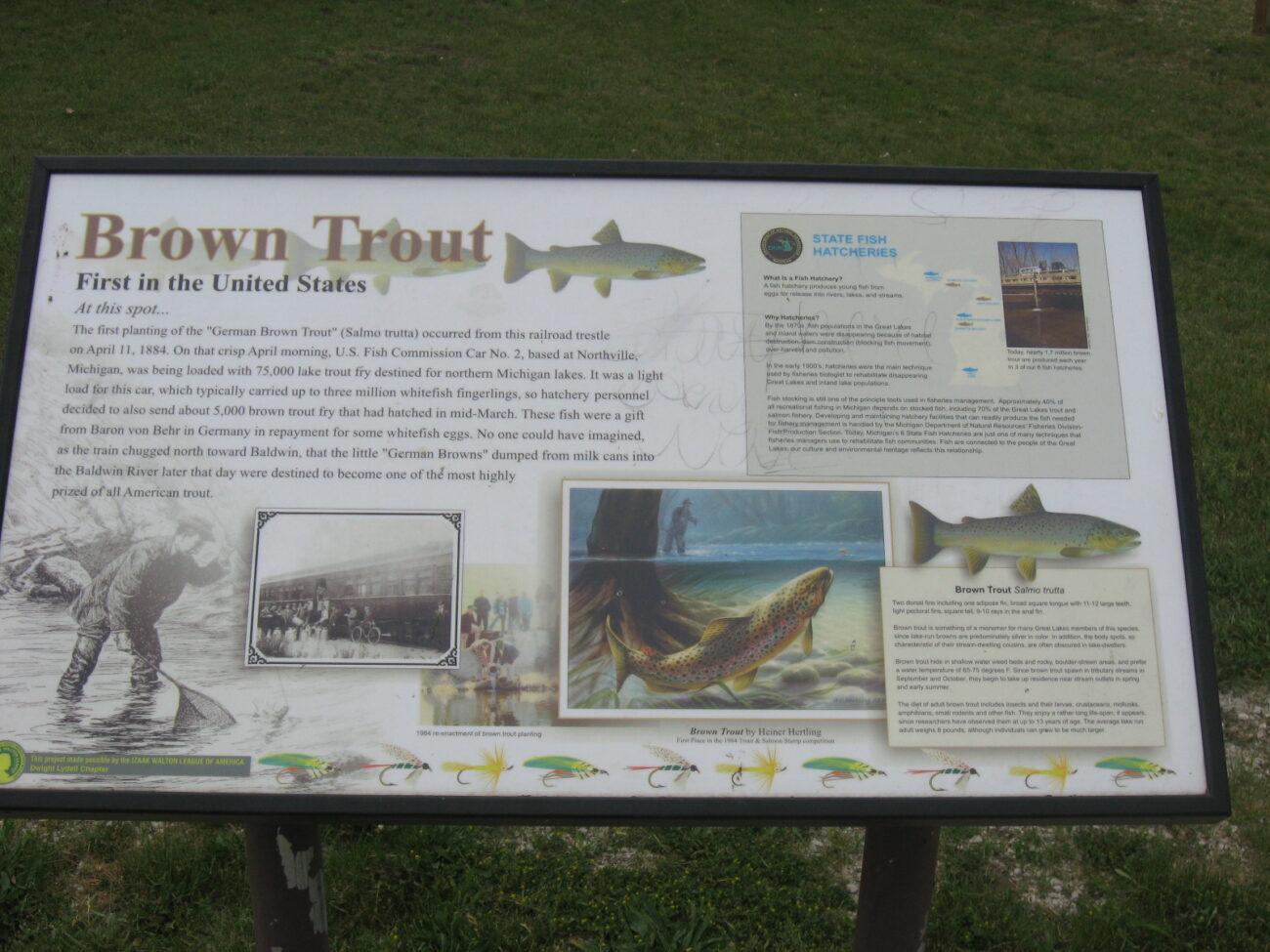
The Baldwin river was at one time known as the North branch of the Pere Marquette river. Its quite amazing that many of the brown trout that are currently swimming around in the areas streams, are possibly direct descendants of these first fish that were planted that day in 1884. The millions of brown trout that have managed to spread so well throughout the entire US, are all because they were dumped off a bridge, from a milk container of all things!
I am Glad I made the stop to see this sign today. I was already in the area to pick up my boat from a friend. If you are ever in western Michigan it is well worth the stop to see this historic place. I have fished the area for quite some time and always really enjoy it. There is great fishing in the Lake county area. The room rates are reasonable and the fishing is amazing. This small community revolves around the fishing industry. This is the type of town where people go into the bar wearing waders and still stinking like the trout they just caught. The Pere Marquette also gets a large Salmon run in the fall and steelhead are available throughout much of the year. There are of course tons of brown trout to catch.
Brown Trout Facts
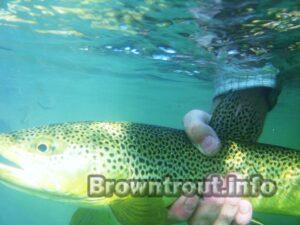
Fact #1: Brown trout eat more than 90% of their food sub surface.
So next time you are dead set on fishing dry flies you might want to reconsider. There are certainly days where you will catch more fish on the surface during a hatch, but not always. Keep this in mind next time you are out fishing for the elusive monster brown trout. Throughout the entire year there are always nymphs and baitfish available underwater for the trout to eat, but there certainly aren’t always flies on the surface of the water. The trout often times just won’t be watching the surface for food. You can float over them all day with a dry fly, if they aren’t looking you aren’t going to catch them.
Fact #2: Brown trout live in the sea.
There are healthy populations of these fish that live in saltwater. They spend most of their lives eating the plentiful supplies of bait fish in the salt and brackish water. They will migrate annually to fresh water in order to breed. Their natural instinct is to ascend rivers to breed, and they will often go as far as they can get in order to do so. The same applies to these fish in the great lakes. They spend most of their lives in deep water out in the lakes, only coming in to rivers to spawn.
They usually spawn in October and November, this is one of the few times in many of their lives that they are susceptible to predation. The spawning migration also coincides with the migration of the salmon. This will frequently lead to very large lake/sea run’s accidentally being caught by salmon fisherman, that otherwise would not have been caught.
Fact #3: Brown trout can lay more than 10,000 eggs!
The survival rate of an individual trout egg is infinitesimally small. Out of the thousands of eggs that are laid by a spawning brown, very few will ever make it to adulthood to spawn themselves. It would be a common scenario for most of the eggs to never have the opportunity to hatch. Of the few that hatch, very few would make it past a few weeks of age. The surviving trout that make it past the “fry” stage will have a great survival instinct, know where to hide and where they are safe. Once they reach a few inches they will begin to grow quickly, but they are still threatened throughout their life by birds, other trout and of course fisherman.
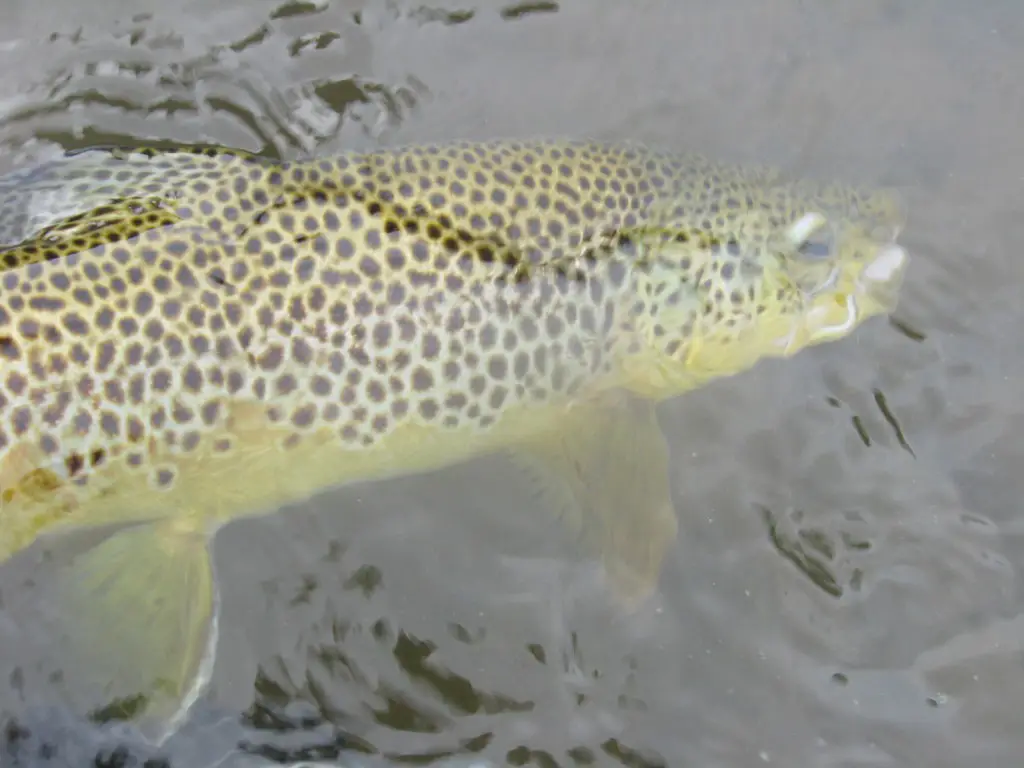
Fact #4: The Brown trout has been stocked in 45 states in the US. There is a self sustaining population in 34 of the 50 states.
They need temperatures that are relatively cold for its survival. Many states have tried to stock thembut were unsuccessful. The preferred temperature is 56-66 degrees F. They can tolerate a lot warmer water than many other trout, but still need cold oxygen rich water to thrive.
Brown Trout Resources
Current and Previous State and World Record Brown Trout: Here you will find a page with all of the current state records for the brown trout. You will also find all of the recent world records here as well. During the last several years the title for the world record brown has changed hands several times. Find out all about it here.
Brown Trout Breeding Habits and Life Cycle: This will offer you some insight into the habits of these trout when they breed, such as desired water temps, and how they choose a suitable area to spawn.
Sub Species of the Brown: Here’s a short article about the various species of this wonderful trout. The sea going species have different scientific names than the resident river browns etc. Learn all about this subject here.
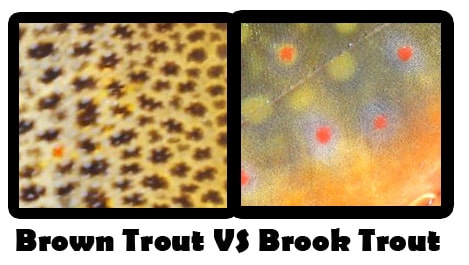 How to Tell the Difference Between Brown and Brook Trout: These 2 trout species are easy to tell apart if you know what to look for. The most distinguishing feature of the 2 species are the average size and the coloration of the spots on these fish. They can also live in the same areas, so it’s a good idea to learn how to identify them at a glance.
How to Tell the Difference Between Brown and Brook Trout: These 2 trout species are easy to tell apart if you know what to look for. The most distinguishing feature of the 2 species are the average size and the coloration of the spots on these fish. They can also live in the same areas, so it’s a good idea to learn how to identify them at a glance.
Brown Trout FAQ
Do Brown Trout have scales?
Brown trout only have small scales, so they don’t always need to be scaled before cooking. You might find it necessary to scrape the fish’s skin with a descaler or the dull side of a knife if you catch a larger trout, probably over 14 inches or so.
Are Brown Trout good to eat?
Brown trout do have somewhat of a fishy flavor, but small brown trout are known to be one of the best tasting trout.

